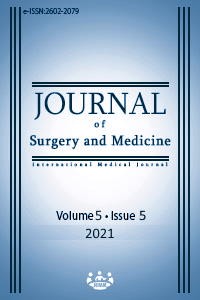A randomized controlled trial of closure or non-closure of subcutaneous fatty tissue after midline vertical incision
Keywords:
Subcutaneous closure, Obesity, Wound complication, Midline vertical incisionAbstract
Background/Aim: There are limited studies that evaluate the closure of subcutaneous tissue, particularly among gynecologic oncology patients, a group with a high rate of obesity and more co-morbidities. This prospective randomized controlled study aimed to assess the effects of subcutaneous closure versus non-closure on wound complication rate in patients with subcutaneous tissue thicknesses of more than >4 cm. Methods: All patients with a subcutaneous tissue depth≥4 cm measured with ultrasonography and undergoing gynecologic surgery via a midline vertical incision from February 2019 to March 2020 in the gynecologic oncology department at a teaching hospital were considered for inclusion. Patients were intraoperatively and sequentially randomized as 1:1 only when the measurement of subcutaneous tissue depth was verified to be 4 cm or more. Results: A total of 82 patients who underwent randomization were assigned to undergo or not undergo subcutaneous closure with sutures (41 patients each). Subcutaneous wound depth (mean: 6.36 cm, range: 4-11 cm), vertical incision length (mean: 24.32 cm, 12-36 cm), body mass index (33.82 kg/m2, 19.6-33.82 kg/m2) were similarly distributed between the groups (P>0.05 for all). Wound complications were observed in 17 (20.7%) patients. Wound infection occurred in two patients in the closure group as compared to three patients in the control group (P=0.644). Seroma and wound dehiscence were seen more often in the control group, but neither of these findings reached statistical significance (P=0.077, P=0.284). Conclusion: We found no significant differences in the rate of surgical wound complications with suture approximation of the subcutaneous tissue in patients with 4 cm or more subcutaneous thickness undergoing gynecologic surgery via a vertical midline incision.
Downloads
References
Nugent EK, Hoff JT, Gao F, Massad LS, Case A, Zighelboim I, et al. Wound complications after gynecologic cancer surgery. Gynecologic oncology. 2011;121:347–52.
Çakmak BD, Dündar B, Türker ÜA, Temur M, Özdemir H, Üstünyurt E, et al. Evaluation of risk factors for surgical site infection after cesarean section. J Surg Med. 2020;4:960-4.
Soper DE, Bump RC, Hurt WG. Wound infection after abdominal hysterectomy: effect of the depth of subcutaneous tissue. American journal of obstetrics and gynecology. 1995;173:465-71.
Vermillion ST, Lamoutte C, Soper DE, Verdeja A. Wound infection after cesarean: effect of subcutaneous tissue thickness. Obstet Gynecol. 2000;95:923-6.
Witte MB, Barbul A. General principles of wound healing. Surgical Clinics of North America. 1997;77:509-28.
Cardosi RJ, Drake J, Holmes S, Tebes SJ, Hoffman MS, Fiorica JV, et al. Subcutaneous management of vertical incisions with 3 or more centimeters of subcutaneous fat. American journal of obstetrics and gynecology. 2006;195:607-14.
Gurusamy KS, Toon CD, Davidson, BR. Subcutaneous closure versus no subcutaneous closure after non‐caesarean surgical procedures. Cochrane Database of Systematic Reviews. 2014;1.
Ethicon Johnson & Johnson . Coated Vycril Suture Product Information. 4 edn. 2015.
Nygaard IE. & Squatrito RC. Abdominal incisions from creation to closure. Obstetrical & gynecological survey. 1996;51:429-36.
Diener MK, Voss S, Jensen K, Büchler MW, Seiler CM. Elective midline laparotomy closure: the INLINE systematic review and meta-analysis. Annals of surgery. 2010;251:843-56.
Chelmow D, Rodriguez EJ, Sabatini MM. Suture closure of subcutaneous fat and wound disruption after cesarean delivery: a meta-analysis. Obstet Gynecol 2004;103:974-80.
Kore S, Vyavaharkar M, Akolekar R, Toke A, Ambiye V. Comparison of closure of subcutaneous tissue versus non-closure in relation to wound disruption after abdominal hysterectomy in obese patients. Journal of postgraduate medicine 2000;46:26.
Downloads
- 600 840
Published
Issue
Section
How to Cite
License
Copyright (c) 2021 Mehmet Bayrak, Hakan Ozan
This work is licensed under a Creative Commons Attribution-NonCommercial-NoDerivatives 4.0 International License.
















